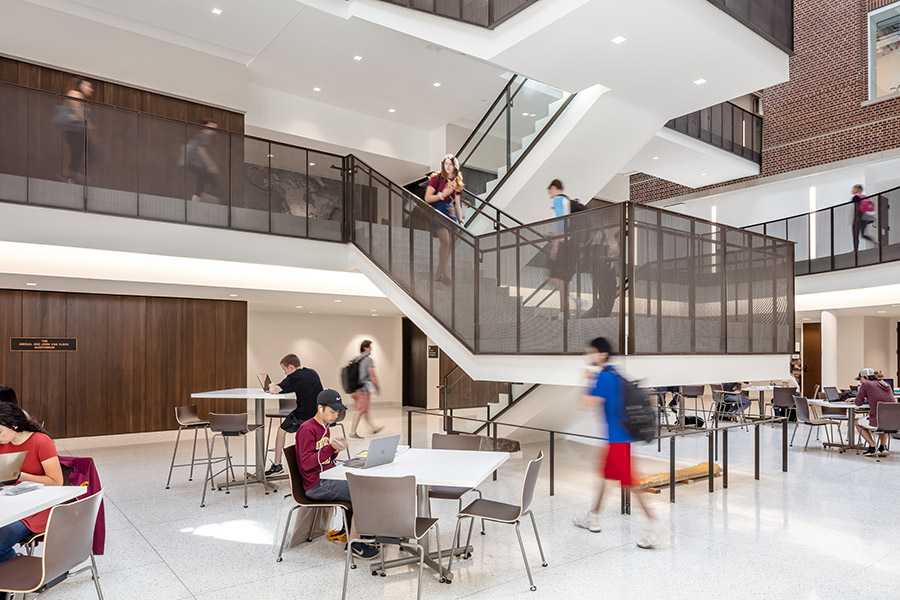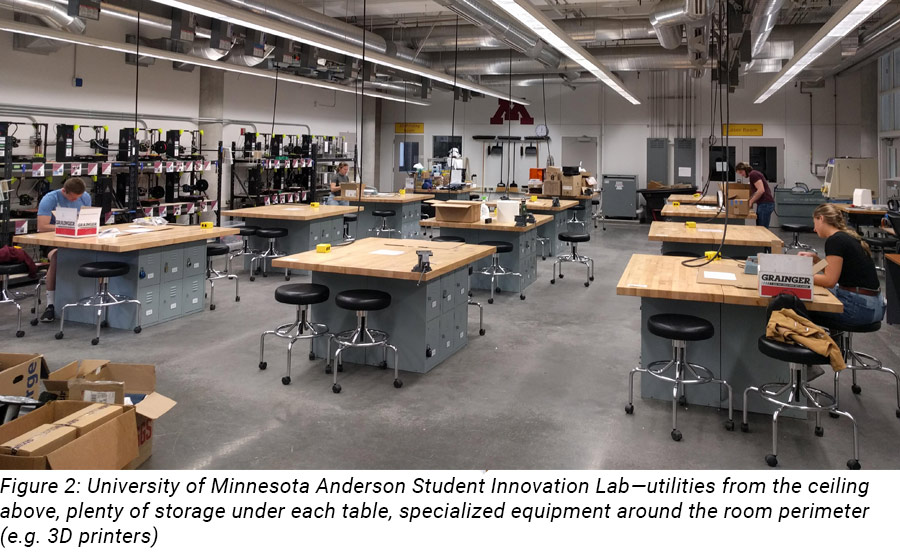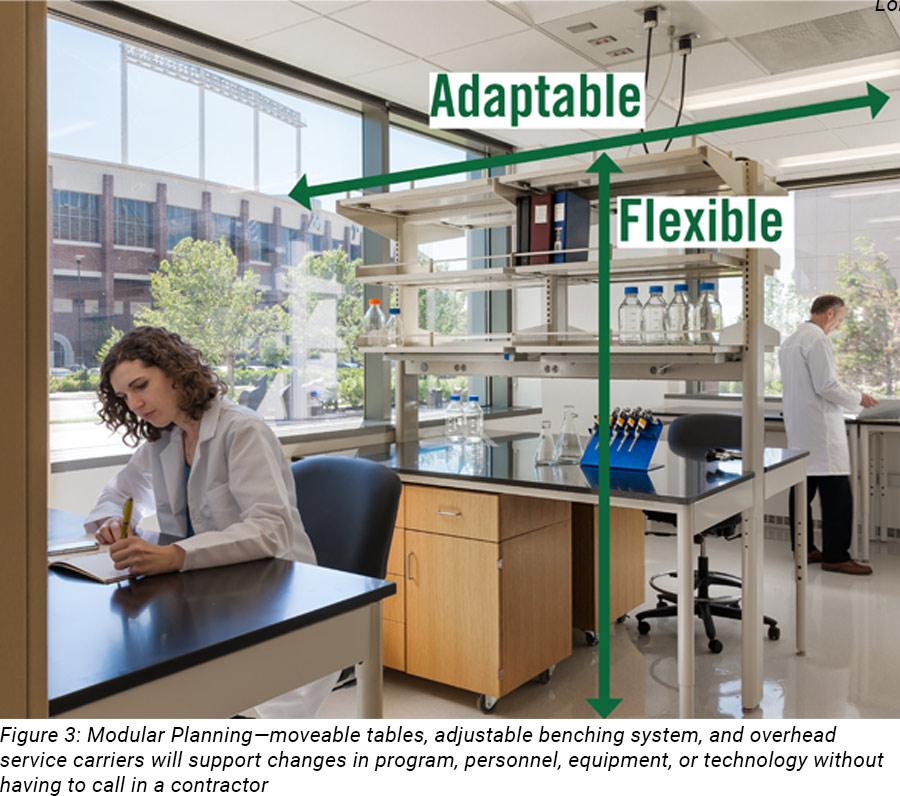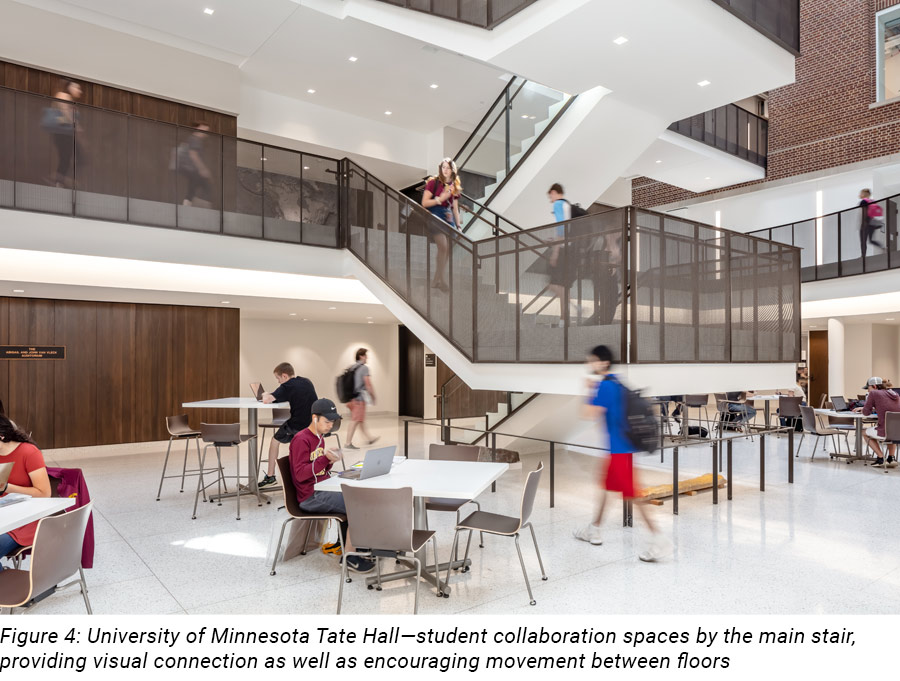
Future of Higher Education Learning Environments
in Perspectives
by Anna Pravinata, AIA, LEED AP, NOMA and Nina Ebbighausen, AIA, LEED AP
Introduction and Objectives
Over the last couple of years, COVID has intensified existing challenges and created new ones within higher education, affecting everything from enrollment and the bottom line to teaching methods and learning spaces. The pandemic has reminded us of what matters in teaching while also providing us with an unprecedented break from “how things always got done,” possibly making us more open to reimagining the future of higher education. Pandemic experiences have revealed the necessity to optimize student learning according to the demands of the post-pandemic era. At the same time, it is reasonable and essential to create spaces that can continue to adapt to support the ever-evolving future of higher ed learning.
This article focuses on drivers-for-change that have affected, or are likely to affect, physical learning spaces and to explore the design possibilities for learning environments that are responsive to recent changes in pedagogy and educational discourse, and that can adapt to continued change. It is important to acknowledge that while optimal teaching is a product of pedagogy, technology, and spaces working together; this particular study focuses mostly on spaces, in terms of how the physical environment provides cues that influence teaching and learning, and less on specific equipment or software that might facilitate teaching and learning.
Background
Learning is more than a process of information transfer; it is a social and cognitive process that is most effective when it integrates mind, body, social systems, and places. We have a unique opportunity right now for bringing together the best of in-person and remote learning in a thoughtful ecosystem that engages all these modalities. When prospective students check out a campus today, they are attracted to the integration of high tech, access to makerspaces, cross-disciplinary curriculums, and student-centered active learning opportunities. They want choices in whether to log into class one day or attend in person the next without compromising learning quality—they want a flexible learning ecosystem that thrives on and off campus.
Procedure
Building on our previous research and conversations with campus leaders and teachers, Alliiance developed a flexible learning ecosystem prototype testing physical and spatial attributes that support a spectrum of teaching strategies. To get participants thinking in preparation for workshop discussion, the following image was provided describing the prototype.
Drivers for this model included the need to quickly modify learning environments in terms of space size, privacy, and formality. This prototype was developed to be able to switch between various modes of teaching, so students can learn in different ways while retaining access to resources, a strong social fabric, and other conditions that support their mental and physical health. Using a series of building block units, the prototype provides a range of learning environments that integrate remote and in-person learning, from small to large, formal to informal, internally focused to collaborative, and passive to active/hands-on. The prototype combines these building blocks into a more complex ecosystem capable of supporting cross-disciplinary activities and mixed learning styles; it is assumed additional configurations can be implemented at different scales, both on and off campus. After the design was completed, the final prototype was presented to workshop participants consisting of three leaders in higher education from three different universities; they were asked to provide input on this flexible learning ecosystem concept.
Discussion Highlights
In this section, we highlight some of the main themes deemed to be significant by the workshop participants and the factors they believed warranted prioritization in relation to the learning environments.
- Flexibility
- Technological Issues
- Spaces for Physical and Mental Health
- Sustainability
Flexibility
Flexibility was the first issue raised during the conversion. Every workshop participant emphasized its importance and the issues they are facing due to the lack of flexibility in higher ed spaces. As Gary Gust, Campus Planner for the University of Wisconsin-Stout, stated, “…our need is to be extremely flexible … so we can teach apparel design one semester and flip it around and become a capstone project (class) for engineering and technology the next… which means we need to have the infrastructure in place so that we can make these changes…”
Mary Holz-Clause, Chancellor of University of Minnesota Crookston, indicated they had some issues because the learning spaces were not designed for biological classes where the instructors need to bring animals and plants to the learning environments. As she said, “When you’re thinking of flexibility… think about what a kindergarten room brings in, you know… everything…”
Continuing this line of discussion, AnnMarie Thomas, University of St. Thomas professor for the Department of Mechanical Engineering in the School of Engineering and the Department of Entrepreneurship in the Opus College of Business, added that some items are not easily changeable after their installation, such as elevators and fume hoods. Hence, flexible learning environments should include elevators with the capacity to carry heavy devices, even if they are not necessary for the current functions of the building.
In terms of classroom size, Gary mentioned that “We are getting rid of tiered classrooms and big, 300+ occupant lecture halls and moving toward 50 occupant rooms (with room to space 20 student classes).” AnnMarie added that “we are moving all classes below 30-35 students (with just a few at 70), without fixed tables, except for computer labs.”
Another issue addressed by the participants was that not only do the higher ed spaces need to be flexible for different activities, but they also should be flexible for the changes coming in the upcoming years. As Gary said: “because in two years from now, the space that we designed for a specific purpose will be used for a different one.” He further explained that:
- “Sometimes we’ve got to wait 30 years for a renovation … We have one space that’s now standing empty for 20 years because the staff left…”
Mary noted that the University of Minnesota is a land-grant university, making it paramount that spaces are created for everybody and curricula have reciprocity with industry to meet the workforce needs of the region.
Technological Issues
Technological problems have been a major issue addressed by all the participants because such issues tend to act as an obstacle to keeping up with imperative changes that learning environments face on an ongoing basis. Mary said:
- “Technology… I think that’s been such a hindrance because it isn’t very flexible at times… I just get so frustrated, it’s like, no, we can’t do that…”
As she further explained: “My experience with technologists is (that) they like things fixed… you have to move all the time… you’re always moving things …and so it’s just a challenge … we need flexibility.” She added that one of the challenges of designing new learning environments would be to figure out how to place these fixed technologies in a flexible environment. As she explained, the technological devices are stuck in places that are not necessarily the best locations for learning and then the campus managers always have to design around where the technology is placed instead of the other way around. She noted that it is imperative to “… think about things that we can’t even imagine now…”
Another issue mentioned by Gary was that the current infrastructures that were installed decades ago are no longer even nearly adequate for the data they currently need to move. He explained that the pathways are so full of old and abandoned cables that they cannot bring in fiber cables required for new technologies.
One other interesting point addressed by the participants was related to wireless technologies. More than one participant mentioned that while in the last decade many campuses opted to become wireless, recently they are bringing back computer labs. AnnMarie explained that “…we need computers that are more expensive than our students typically are going to have that are faster and aren’t running off of Wi-Fi for serious programs.” So, as they stated, accommodating computer labs in the flexible units should be taken under consideration.
When one of the moderators asked about the possibility of adjacency or direct access to other spaces, AnnMarie said that the situation is unique for each university, and in their case, media spaces have become a priority because more and more things are going online.
Spaces for Physical and Mental Health
Mary addressed the issue of ergonomics and stated that “people are spending so much time at those (desks), we need that flexibility, …so even in a computer (lab) people can move, can get up and move around or work, however, they want to…, (to) prevent some of those long-term chronic things.” So, she continued, “The design needs to think about the entirety and the holistic perspective.”
The necessity of providing spaces for social interaction was another point deemed of high importance by participants. Gary commented that, “students are craving this opportunity to actually interact, and I think with all this technology… they still (crave it) …” he added that,
- “…we were worried that these students were getting isolated and just being there (by) themselves, taking their classes…”
Addressing the necessity for considering the issue of inclusion and equity in design process, Mary stated that, “The old days are gone. Spaces need to be accessible for older returning students and those taking a less linear approach to education. Tailor higher ed spaces to meet the needs of prospective students.” AnnMarie added that “(especially for commuter students) we want the students to be comfortable hanging out on campus and in spaces… so sometimes that’s a classroom that is not being used… (where there are) configurable tables, (outlets), and whiteboards, they’re always there.”
Referring to the climate situation in the northern part of U.S., Mary maintained that “I notice it obviously plays a huge (role) on people’s mental health when they feel trapped, when they feel like they don’t have those outs… You can’t go outside [in the winter], and so we need to create better inside spaces.” She added that:
- “They (designers) need to spend more time on helping people to be physically active and support (this) in their inside environments … and take (any) opportunity that we can create to facilitate social interaction.”
Sustainability
Gary addressed the issue of sustainability and stated that “One thing that’s really important to our students is sustainability…, and I think if you’re putting out a prototype, you need to talk about sustainability…”
He added that one important matter would be the daylighting, as the students congregate towards natural light. He also notes that this can be problematic with all the screens, so trying to figure out how to have both can become a challenge. The participants also addressed the necessity of incorporating green environment in design while referring to the term “biophilia.” Mary added that:
- “Most of our students come from environments that have a lot of green in them … (we want space) where your students feel comfortable where they’re going to congregate, and they’re going to congregate into those aesthetically appealing spaces for them.”
The issue of hygiene was also brought up, as Mary noted there has been a new awareness among students about “how things… could be cleaned quickly and sanitized.”
Conclusion
At the end, all participants addressed the current status of higher education. As Gary explained, “60% of buildings were built in a 40-year period and are not about 60 years old. Universities are needing to spend to upgrade infrastructure, leaving less money for academic spaces, as enrollments are dropping post-COVID.” AnnMarie added that students are savvier about what they are paying for in higher ed, and Mary stated that:
- “Lots of universities will close, will not be financially viable. Others will have to reinvest (within a budget), deciding what they are offering. Spaces will need to be incredibly flexible to meet a variety of needs, backgrounds, ages, goals, etc. At the same time, there’s still a need for students on campus, given a “college experience” rather than the university moving outward. The dorm is still part of the desired experience.”
Mary continued that, “we understand that the old days are gone, and that we haven’t been as effective as we thought we were, and that we can start to experiment and look at things differently… otherwise we’re going to become irrelevant and they’re (students are) going to go other places.” Hence, as Gary stated:
- “…In the design of this building for people… we should think about things differently than we traditionally have,”
Because as Mary emphasized, “nobody owns them (spaces)… everybody owns them.”
The post-pandemic learning environment needs the ability to switch easily between various modes of teaching so students are empowered to learn in different ways and the flexibility to keep pace with continuing change in the future. These environments also need to be sustainable and be able to adapt to incorporate future technological advancements. In addition, the learning environment needs to provide students with access to resources, a strong social fabric, and other conditions that support their physical and mental health. By using a series of building block units, the flexible learning ecosystem prototype developed in this study supports a range of learning environments that integrate remote and in-person learning—from small to large; formal to informal; internally focused to collaborative; and passive to active/hands-on. The next step for us is to develop and test in-situ physical prototypes and continue to explore what optimal future learning environments should look like.





